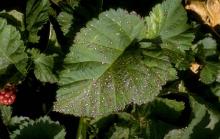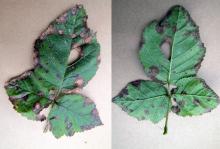See:
Blackberry Cultivar Susceptibility
Cause Sphaerulina westendorpii (formerly Septoria rubi), a fungus that affects trailing berries such as 'Marion' and 'Santiam' blackberries, 'Boysenberry', and 'Loganberry'. This species does not infect raspberry. Minute, black, fruiting bodies (pycnidia) are formed within infected tissue, mature, and produce spores. Rain spreads spores to healthy tissue. In winter, the sexual spore stage forms on old dead leaves and on infected canes. During the wet early spring, more spores are produced, and these cause many new infections.
Symptoms Leaf spots vary from light to dark brown. At first they are about 0.12 inch in diameter and purplish in color. They later turn brown. In older leaf spots, centers are whitish with brown to red borders. Small black dots (pycnidia) may occur near the center of the lesions. Severe disease can lead to premature defoliation. Infections on canes are similar to those on leaves but are generally inconspicuous. During wet seasons in Oregon, a brown fruit rot has been found on 'Loganberry'. Lesions due to anthracnose may look similar. Blackberry rust may also look similar on the upper surface of a leaf but has yellowish pustules in the same location on the underside of that leaf.
Cultural control
- Alternate-year (AY) fruiting program. The disease has not been a problem in AY-producing fields if canes are trained to the trellis as they grow. If canes are allowed to lie on the ground, leaf and cane spot can be just as severe as in fields where berries are harvested annually.
- Remove old fruiting canes after harvest.
- Trellis canes in August through early September or wait until late winter (February or March). Canes trained after early September may be more susceptible to winter injury.
- Control weeds because they can provide a natural "moist chamber" for infection and prevent effective spray coverage.
- Use plant spacing and canopy management that promotes good air circulation.
Chemical control Tank-mix and/or alternate products from different groups with different modes of action to prevent the build-up of resistant fungi. Minimize the use of any one group during the growing season.
- For every-year (EY) producers, spray after harvest.
- Fixed coppers such as Nu-Cop, C-O-C-S, Nordox, Cuprofix, or Kocide most with a 48-hr reentry. Monterey Liqui-Cop or Bonide Copper Fungicide for the home. H O
- Rex Lime Sulfur Solution (28%) at 0.5 to 1.25 gal/100 gal water. 48-hr reentry. O
- Spray again in early October before heavy rains begin.
- Bordeaux 8-8-100. O
- Fixed coppers such as Nu-Cop, C-O-C-S, Nordox, Cuprofix, or Kocide most with a 48-hr reentry. O
- Spray again at budbreak in early March.
- Rex Lime Sulfur Solution (28%) at 6 to 12 gal/100 gal water. May burn leaves when shoots are 0.75 inch or longer. 48-hr reentry. O
- Fixed coppers such as Nu-Cop, C-O-C-S, Nordox, Cuprofix, or Kocide most with a 48-hr reentry. O
- Sulforix at 3 gal/100 gal water. Apply as a delayed dormant spray. 48-hr reentry.
- Spray young primocanes at 0 to 6 inches growth, 12- to 18-inch growth and 2- to 3-foot growth.
- Abound at 6 to 15.5 fl oz/A. Do not apply with silicone-based surfactants. May be applied on the day of harvest. Group 11 fungicide. 4-hr reentry.
- Bonide Captan 50 WP at 3 Tbsp/gal water can be used in home gardens - Washington only. Do not use within 3 days of harvest. H
- Cabrio EG at 14 oz/A. May be used on day of harvest. 12-hr reentry.
- Captan 80 WDG at 2.5 lb/A. Do not apply within 3 days of harvest. Group M4 fungicide. 48-hr reentry.
- Cevya at 4 to 5 fl oz/A. May be used day of harvest. Group 3 fungicide. 12-hr reentry.
- Fixed coppers (such as Kocide, Nu-Cop, or C-O-C-S). 48-hr reentry. O
- Luna Tranquility at 16 to 27 fl oz/A. May be used day of harvest. Group 7 + 9 fungicide. 12-hr reentry.
- Pristine at 18.5 to 23 oz/A. Do not use with any other tank additive. Can be used day of harvest. Group 7 + 11 fungicide. 12-hr reentry.
- Propiconazole-based fungicides are registered. Do not use within 30 days of harvest. Group 3 fungicides.
- PropiMax EC at 6 fl oz/A. 12-hr reentry.
- Tilt at 6 fl oz/A. 24-hr reentry.
- Quadris at 6 to 15.5 fl oz/A. Do not apply with silicone-based surfactants. May be applied on the day of harvest. Group 11 fungicide. 4-hr reentry.
- QuiltXcel at 14 to 21 fl oz/A. Do not use within 30 days of harvest. Group 3 + 11 fungicide. 12-hr reentry.
- Spectracide Immunox Multi-Purpose Fungicide Spray Concentrate for Gardens at 0.67 fl oz/gal water. May be applied up to the day of harvest. Group 3 fungicide. H
- Tanos at 8 to 10 oz/A plus a copper-based fungicide. Can be used day of harvest. Group 11 + 27 fungicide. 12-hr reentry.
Reference Martin, R.R., Ellis, M.A., Williamson, B., and Williams, R.N. 2017. Compendium of Raspberry and Blackberry Diseases and Pests. 2nd edition. St. Paul, MN: APS Press.






